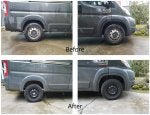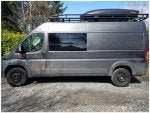This type of spacer (fitting between head of strut and strut mounting location) is a pretty common thing for some other vehicles. There are, for example, numerous versions available for Subarus, and I have seen a couple for Toyota Siennas. Great debate rages on how much is too much . At some point - presumably a different point with each particular vehicle - you get into issues with the CV joints because of the altered angle, or the tie rods, etc. Having looked around at many opinions of the various amounts of lift achieved on Subarus, I can say there is not much consensus on the top end - some folks claim 3' or even 4" works fine, while others balk at anything over 1 1/2". With the Subarus, there are a lot of these kind of lifts on the road, and it seems like the smaller lifts, 1 or 1 1/2", are pretty widely accepted, the 2" fairly so, and beyond that the serious arguments begin, and/or the serious related modifications to avoid problems. Materials and precise configurations do vary with the ones I've seen for other vehicles, with some units having geometry built-in to compensate to some extent for the altered angles produced by the lift, while others don't have that. The Van Compass units have a different fabrication method than any others I've seen, but principles are exactly the same, and these are the simplest sort, where it is just a straight shim, no offsets to the side or angles involved.
Another point, though probably not very applicable to a van, is that while these shims do not compress the springs and thus do not reduce spring travel so that you bottom out sooner, they can do the opposite; if the strut is lowered enough you can reach a point where the a-arms hit bottom before the strut is fully extended and thus you can "top out" on a rebound or a dropoff. Like I say, probably not an issue with a van as few people are going to drive one of these aggressively enough to encounter the situation, but I though I'd mention it because I've seen it discussed in relation to this type of lift on other vehicles.







